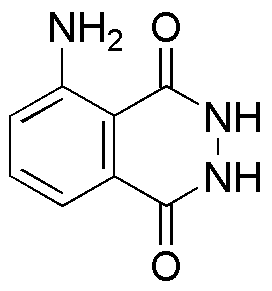Luminol is widely utilized in research focused on:
- Forensic Science: Luminol is famous for its ability to detect trace amounts of blood at crime scenes, even after it has been cleaned. This application is crucial for forensic investigators in gathering evidence.
- Chemiluminescence Studies: Researchers use Luminol in studies of chemiluminescence, where it emits light when it reacts with certain chemicals. This property is leveraged in various scientific experiments and demonstrations.
- Biological Research: In biology, Luminol is used as a reagent to detect reactive oxygen species (ROS) in cells, helping scientists understand oxidative stress and its implications in diseases.
- Environmental Monitoring: The compound can be utilized to detect pollutants and contaminants in water samples, providing a quick and effective method for environmental scientists to assess water quality.
- Medical Diagnostics: Luminol's luminescent properties are applied in certain diagnostic tests, particularly in immunoassays, enhancing the sensitivity and accuracy of detecting specific biomolecules.
General Information
Properties
Safety and Regulations
Applications
Luminol is widely utilized in research focused on:
- Forensic Science: Luminol is famous for its ability to detect trace amounts of blood at crime scenes, even after it has been cleaned. This application is crucial for forensic investigators in gathering evidence.
- Chemiluminescence Studies: Researchers use Luminol in studies of chemiluminescence, where it emits light when it reacts with certain chemicals. This property is leveraged in various scientific experiments and demonstrations.
- Biological Research: In biology, Luminol is used as a reagent to detect reactive oxygen species (ROS) in cells, helping scientists understand oxidative stress and its implications in diseases.
- Environmental Monitoring: The compound can be utilized to detect pollutants and contaminants in water samples, providing a quick and effective method for environmental scientists to assess water quality.
- Medical Diagnostics: Luminol's luminescent properties are applied in certain diagnostic tests, particularly in immunoassays, enhancing the sensitivity and accuracy of detecting specific biomolecules.
Documents
Safety Data Sheets (SDS)
The SDS provides comprehensive safety information on handling, storage, and disposal of the product.
Product Specification (PS)
The PS provides a comprehensive breakdown of the product’s properties, including chemical composition, physical state, purity, and storage requirements. It also details acceptable quality ranges and the product's intended applications.
Certificates of Analysis (COA)
Search for Certificates of Analysis (COA) by entering the products Lot Number. Lot and Batch Numbers can be found on a product’s label following the words ‘Lot’ or ‘Batch’.
Número de catálogo
Número de lote/lote
Certificates Of Origin (COO)
This COO confirms the country where the product was manufactured, and also details the materials and components used in it and whether it is derived from natural, synthetic, or other specific sources. This certificate may be required for customs, trade, and regulatory compliance.
Número de catálogo
Número de lote/lote
Safety Data Sheets (SDS)
The SDS provides comprehensive safety information on handling, storage, and disposal of the product.
DownloadProduct Specification (PS)
The PS provides a comprehensive breakdown of the product’s properties, including chemical composition, physical state, purity, and storage requirements. It also details acceptable quality ranges and the product's intended applications.
DownloadCertificates of Analysis (COA)
Search for Certificates of Analysis (COA) by entering the products Lot Number. Lot and Batch Numbers can be found on a product’s label following the words ‘Lot’ or ‘Batch’.
Número de catálogo
Número de lote/lote
Certificates Of Origin (COO)
This COO confirms the country where the product was manufactured, and also details the materials and components used in it and whether it is derived from natural, synthetic, or other specific sources. This certificate may be required for customs, trade, and regulatory compliance.


